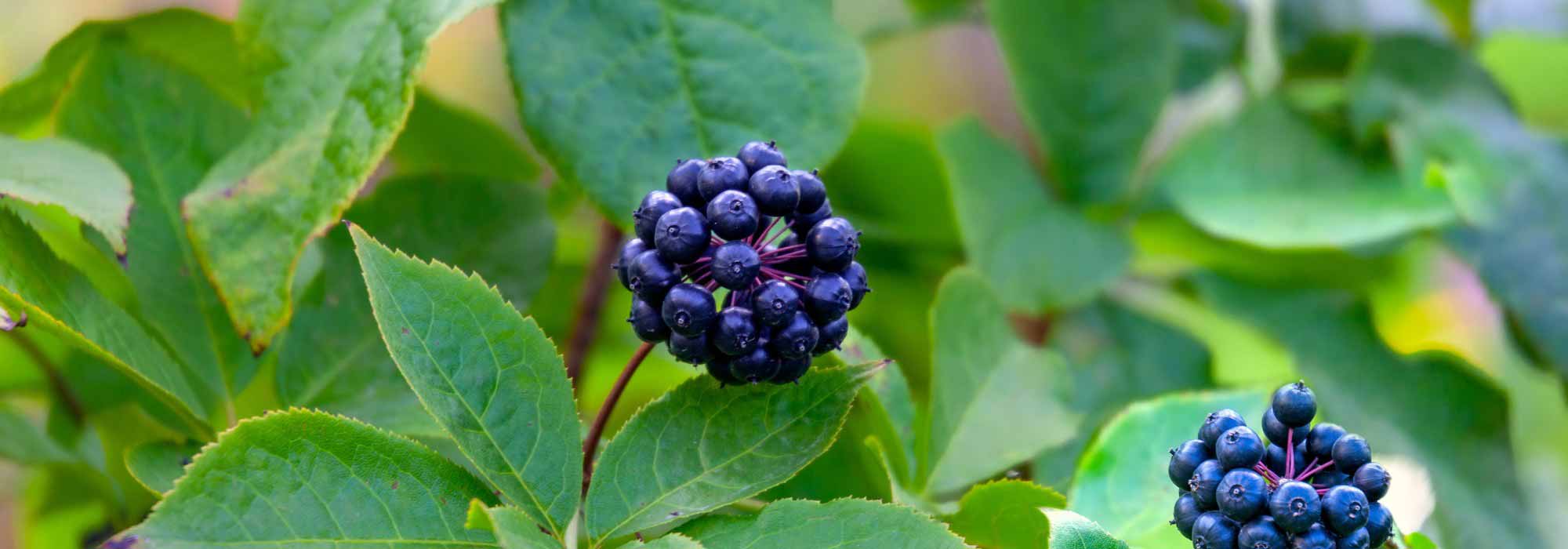
Eleutherococcus, Acanthopanax: planting, growing, and maintaining
Contents
Eleutherococcus in a nutshell
- Eleutherococcus is a small thorny bush with an elegant habit
- It bears beautiful, lush and exotic-looking cut foliage
- In summer, it produces small white flowers, followed by tiny black berries on female plants
- Perfectly hardy and easy to grow, it adapts to any soil that remains moist in summer
- It brightens up shady areas and can even be planted as a hedge
The word from our expert
TheEleuthero or Eleutherococcus (syn. Acanthopanax) is a small, thorny bush that is unjustly overlooked, closely related to the Japanese Aralia. It shares with its close cousin a lush, palmate foliage, evoking exoticism and brightening the shadiest corners of the garden. In summer, it offers a discreet white flowering, followed by small decorative black berries until late autumn. Highly adaptable, this perfectly hardy bush thrives in any soil that remains moist during summer, in partial shade. It requires little maintenance, apart from the regular removal of suckers that appear. It fits equally well in a hedge or a shrub border, or even in woodland undergrowth. Its graphic habit and deterrent thorns make it an ideal choice for naturalistic or Japanese-style gardens, or for creating a defensive hedge that is both elegant and effective. Additionally, the root of Eleutherococcus senticosus is renowned for its benefits in herbal medicine, particularly for its ability to increase resistance to stress. Discover this easy and undemanding bush, perfect for lovers of exotic and woodland atmospheres!
Botany
Botanical data
- Latin name Eleutherococcus
- Family Araliaceae
- Common name Eleuthero, Acanthopanax, Siberian ginseng
- Flowering June to September
- Height 1.30 m to 3 m
- Sun exposure Sun, partial shade
- Soil type Fresh, ordinary soil
- Hardiness -18°C
Eleuthero (formerly known as Acanthopanax) belongs to the Araliaceae family, which includes over 1,500 species, such as the Aralia elata (“Japanese angelica tree”), to which it is closely related, ivy (Hedera helix), ginseng (Panax ginseng), and Fatsia. This Asian shrub originates from central and western China, the Philippines, and Japan. This plant thrives in temperate zones, where it grows in undergrowth, humid forests, and on mountain slopes. Its adaptation to these environments allows it to tolerate a wide range of climatic conditions.
The genus comprises around thirty species of spiny shrubs and trees, the most well-known of which include Acanthopanax or Eleutherococcus henryi (Henry’s eleuthero), Acanthopanax sieboldii, now called Eleutherococcus sieboldianus (Siebold’s eleuthero), prized for their ornamental qualities, as well as Acanthopanax senticosus (Eleutherococcus senticosus), sometimes nicknamed “Japanese ginseng” or “Siberian ginseng,” often used in herbal medicine.
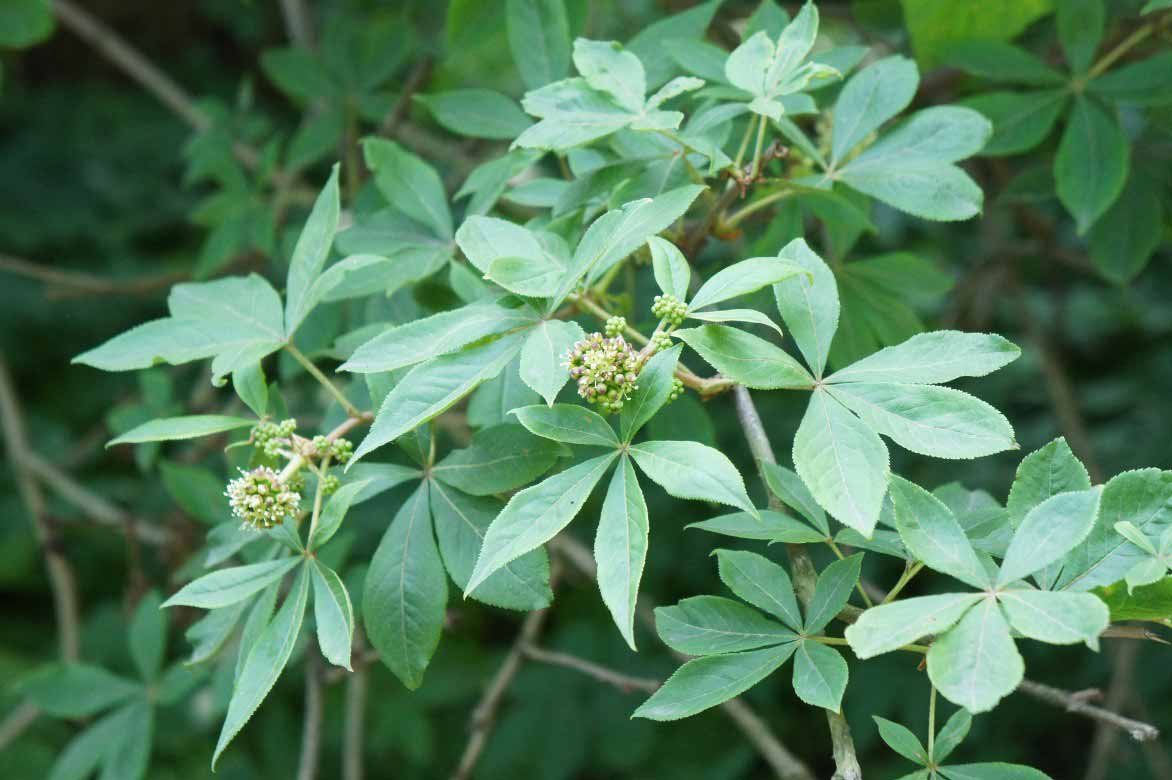
The palmate foliage of Eleutherococcus senticosus
The size of Eleuthero varies depending on the species and variety, ranging from 1.50 m for dwarf varieties to about 2-3 metres in height. In its natural habitat, it can reach up to 3.50 m tall. It has a spreading form and a bushy habit, both dense and elegant. The arching branches are densely ramified and armed with slender, deterrent thorns, giving it a compact and bushy appearance, ideal for defensive hedges, earning it the nickname “Devil’s bush.”
The deciduous foliage appears in spring, quite late. Palmate and ornamental, it is typical of the Araliaceae family, with a lush appearance. Each leaf is divided into five leaflets with dentate margins, arranged in a star around a central, sometimes thorny petiole. They unfurl at the tips of the branches, creating an umbrella-like effect. They often have a slightly leathery texture and a rough upper surface, measuring 3 to 8 cm in length. Eleutherococcus henryi stands out with larger and more numerous leaves. Each leaf can have up to nine leaflets, which are elongated and pointed, sometimes measuring up to 15 cm long. The leaves are usually green to grey-green, turning golden yellow in autumn before falling. Some varieties, such as Acanthopanax sieboldii ‘Variegatus’, are distinguished by their bright cream-variegated foliage.
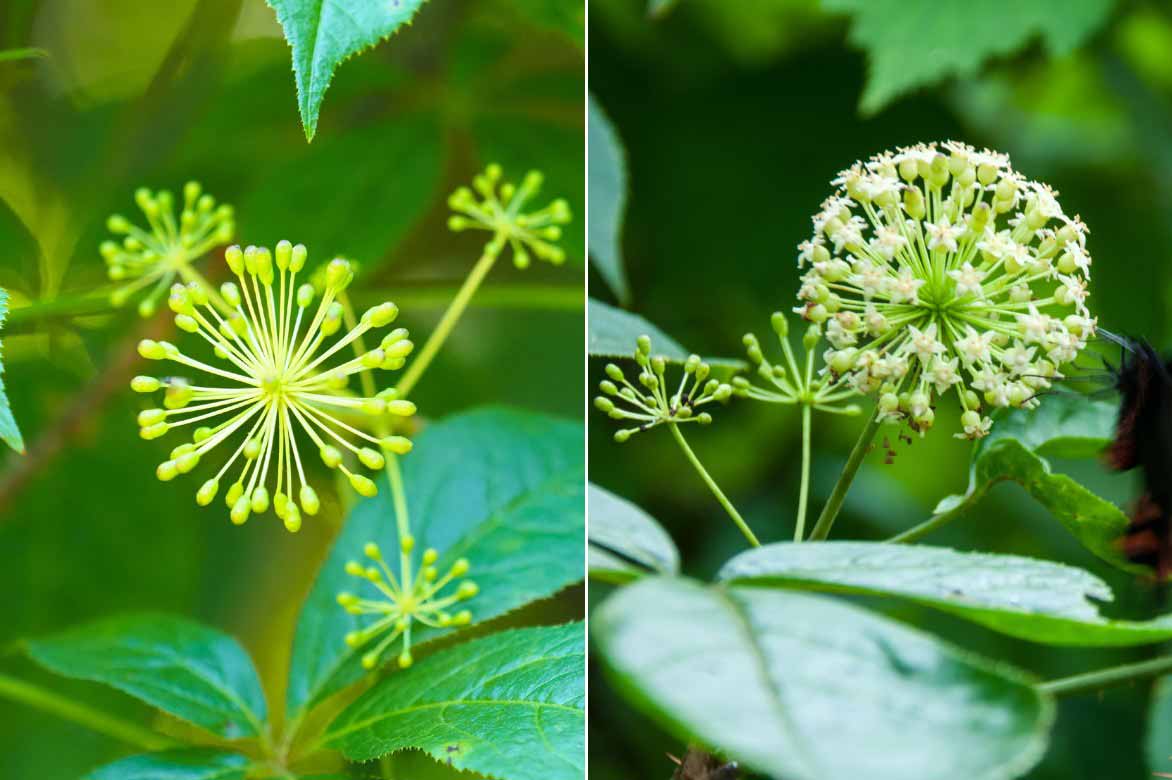
The flowering of Eleuthero
The flowering of Eleutherococcus typically occurs between June and September, earlier or later depending on the climate. It appears as small flowers grouped in umbels 2 to 3 cm in diameter, at the tips of the branches. The flowers are creamy white to pale yellow, relatively inconspicuous due to their small size, arranged in tight, airy clusters. Each flower consists of five petals surrounding a prominent stamen centre. Though not fragrant, the flowers are nonetheless melliferous, attracting pollinating insects, particularly bees.
Only female plants can produce fruit. Female flowers must be pollinated by pollen from male flowers: once pollination is successful, the female flowers give way to small, ovoid fruits that turn black when ripe, resembling those of ivy. These glossy berries, arranged in tight clusters, often grouped into balls about 5 cm in diameter, sometimes persist until winter. Each contains five yellow seeds.
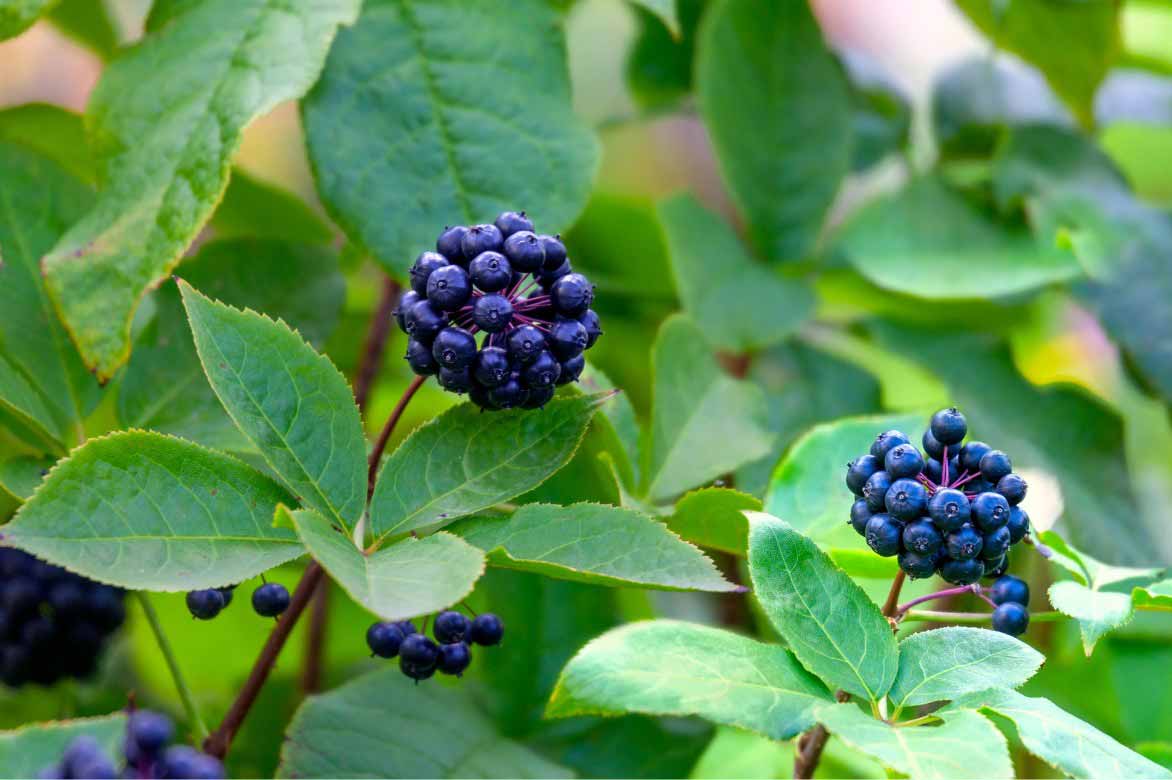
The fruits of Eleuthero
Main species and varieties
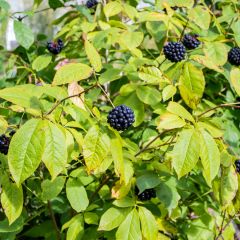
Acanthopanax henryi - Henry's Aralia
- Flowering time September, October
- Height at maturity 2 m
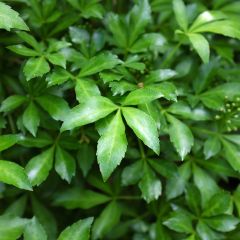
Acanthopanax henryi Nana - Henry's Aralia
- Flowering time July, August
- Height at maturity 1,30 m
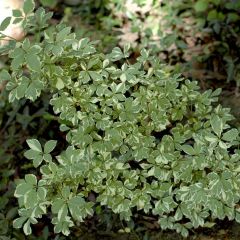
Acanthopanax sieboldianus Variegatus
- Flowering time July, August
- Height at maturity 2 m
Planting
Where to plant?
Hardy down to -18°C, the Eleutherococcus or Acanthopanax can be grown in the ground in many regions. However, it is advisable to plant it in a spot sheltered from cold, drying winds to protect its foliage and young shoots. A location near an east- or north-facing wall or under the canopy of taller trees can provide this natural protection. The ideal exposure is partial shade or dappled shade, although it can also tolerate deeper shade. In warmer regions, a partially shaded spot, especially sheltered from direct afternoon sun, is essential to prevent the foliage from scorching. In cooler areas, a sunnier exposure can be beneficial to encourage flowering and fruiting.
Very adaptable, though it thrives in various soil types, it will perform best in any good garden soil, well-drained and rich in organic matter. As a true forest plant, a humus-bearing soil that remains cool in summer will support its growth. It tolerates dry shade well. It only fears scorching exposures and waterlogged soils.
It is perfect for planting along woodland edges, in shrub borders, in mixed shrub beds, or even in a hedge, whether free-growing or clipped, defensive or not. With its highly ornamental foliage, it fits perfectly into a naturalistic, Japanese-style, or exotic garden. The variegated varieties are ideal for bringing light to shady corners of the garden.
When to plant?
You can plant the Eleutherococcus in autumn (September to October) or in spring (March to May), avoiding periods of frost or extreme heat.
How to plant?
- Loosen the soil to a depth of about 30 to 40 cm to facilitate rooting. If the soil is heavy or clayey, incorporate compost or potting soil to improve drainage and soil structure.
- Soak the root ball in water for a few minutes to moisten it.
- Dig a hole twice as wide and deep as the root ball.
- Place the Eleutherococcus in the centre of the hole, ensuring the top of the root ball is level with the collar.
- Backfill, then lightly firm the soil around the root ball to eliminate air pockets without compacting excessively.
- Water generously after planting to help the plant establish. A mulch can be spread around the bush to retain moisture and protect the roots.
- Continue to water regularly.
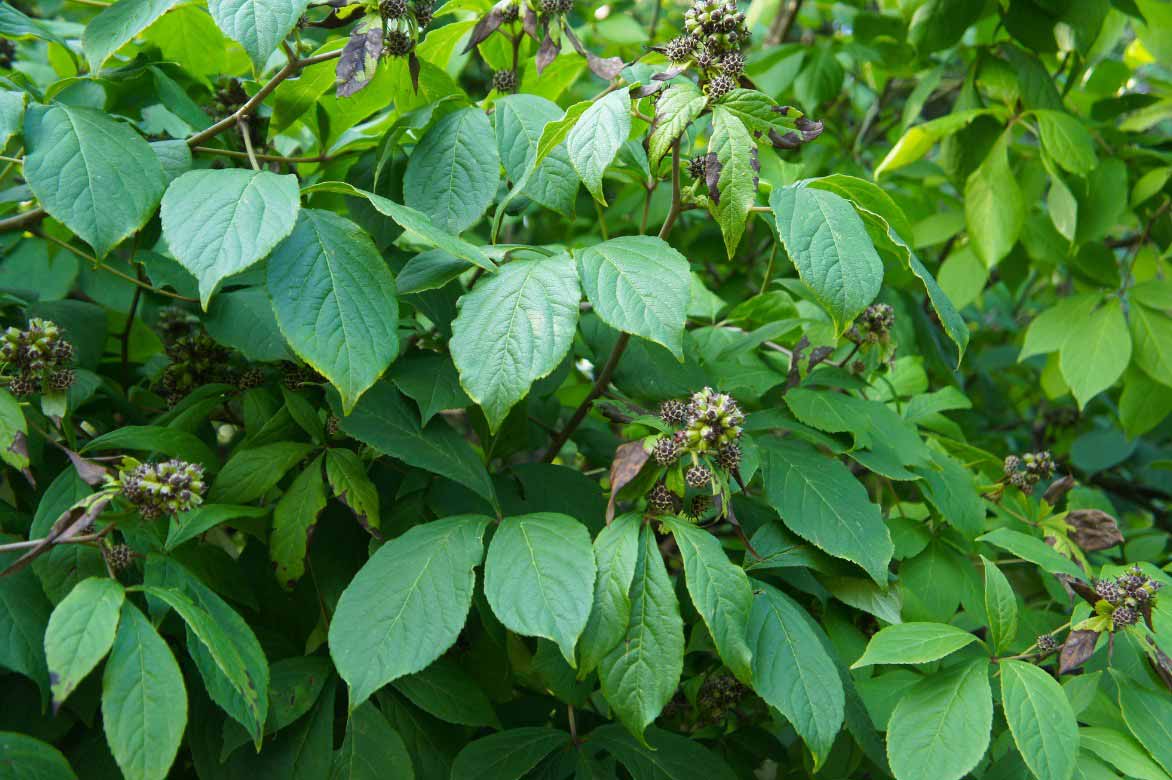
Eleutherococcus sessiliflorus
Maintenance, pruning and care
Maintaining the Eleutherococcus is relatively straightforward. This is a robust and undemanding bush that will appreciate regular watering, especially during the first few years after planting and during dry spells. Mulching around the base will help retain soil moisture. In spring, you can apply organic fertiliser or well-rotted compost to the stump to enrich the soil, and lightly work it in with a simple rake.
The Eleutherococcus is not prone to diseases or pests.
Pruning
Pruning the Eleutherococcus is generally unnecessary. However, light pruning can be done to encourage ramification, control its size, or remove dead, damaged, or diseased branches. Pruning stimulates the growth of new shoots. The best time to prune is in late winter or early spring, in March, before the growing season begins, to encourage ramification and control its size. It tolerates repeated pruning well, which is useful in case of excessive growth. You can cut it back hard every 4 or 5 years.
The Eleutherococcus is a bush that tends to produce suckers. These suckers can quickly spread and colonise the surrounding area, eventually forming a dense ground cover or an impenetrable hedge. To remove them, cut them at the base, as close to the root as possible, using a sharp pruning shear.
Multiplication
We recommend propagating Acanthopanax by taking suckers, which develop on the roots of the parent plant to obtain new young plants. Sowing is also possible if you have access to seeds of the Eleutherococcus, meaning if your tree bears fruit, though this method is more tedious and unpredictable.
Taking Suckers
To propagate the bush, simply:
- Dig up well-formed suckers in late winter, around February or March, taking care to keep some of the roots intact.
- Replant the young shoots directly in another part of the garden or in pots, where they will establish themselves quickly.
Sowing
You can harvest the fruits to collect the seeds they contain. These seeds must be cold-stratified by placing them in the refrigerator for about 3 months. You can then sow them in a mixture of compost and sand, at a temperature between 20 and 30°C. Transplant the young plants once they have 6 to 8 leaves. Allow them to strengthen in pots for a year before transplanting them to their final spot in the garden.
Association
The large palmate leaves of Eleutherococcus create beautiful exotic-themed atmospheres in shady areas of the garden, for example. In a slightly “jungle-like” composition, it can be paired with other well-developed and lush foliage, such as that of Aralia elata, Gunnera, or Fatsia japonica, for interesting contrasts.
In a very natural woodland setting, Eleutherococcus can be planted near hostas, ferns, and Paris polyphylla, a beautiful shade-loving perennial with highly graphic foliage—plants that, like it, thrive in partially shaded areas and rich, organic soils that remain slightly moist.
It also works wonders in a trimmed or free-form hedge alongside other easy-going bushes such as privets or Ligustrum, shrubby honeysuckles, or hedge honeysuckles (Lonicera xylosteum).
Botanical roses and white-flowering spiraeas will also make excellent companions in a natural and wild shrub border. Japanese maples, with their delicate and colourful foliage, also harmonise well, especially if you aim to create scenes inspired by Asian aesthetics. Low-growing, flexible ornamental grasses like Carex or Hakonechloa can thrive alongside it, brightening and covering the ground in shady garden corners.
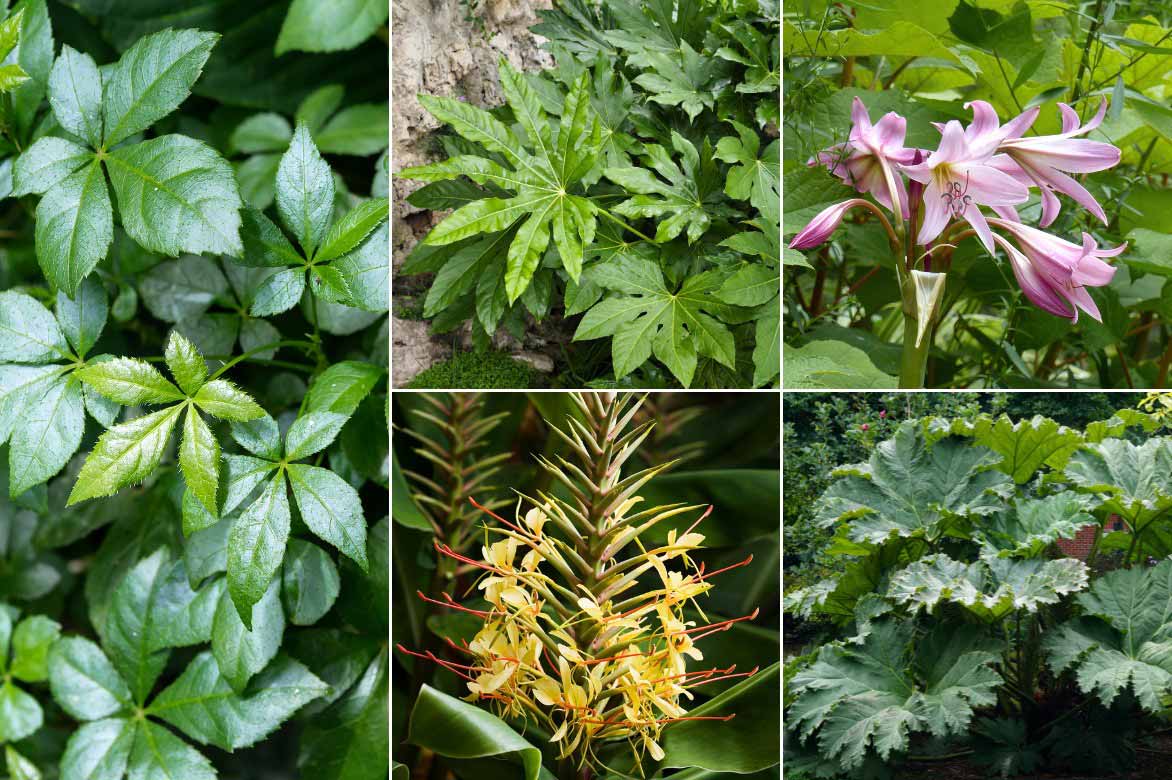
Eleutherococcus will integrate perfectly into an exotic garden, with lush foliage and spectacular flowering. Eleutherococcus trifoliatus, Fatsia japonica, Crinum powellii, Hedychium gardnerianum (photo: J.J. Harrison) and Gunnera manicata
Did you know?
The Eleutherococcus senticosus or “Siberian Ginseng” is commonly used in traditional Chinese medicine for its adaptogenic properties, helping the body to adapt to stress and combat states of weakness. The root, which constitutes the medicinal part of the plant, is typically dried, ground into powder, and then processed and used as a substitute for Ginseng.
- Subscribe!
- Contents
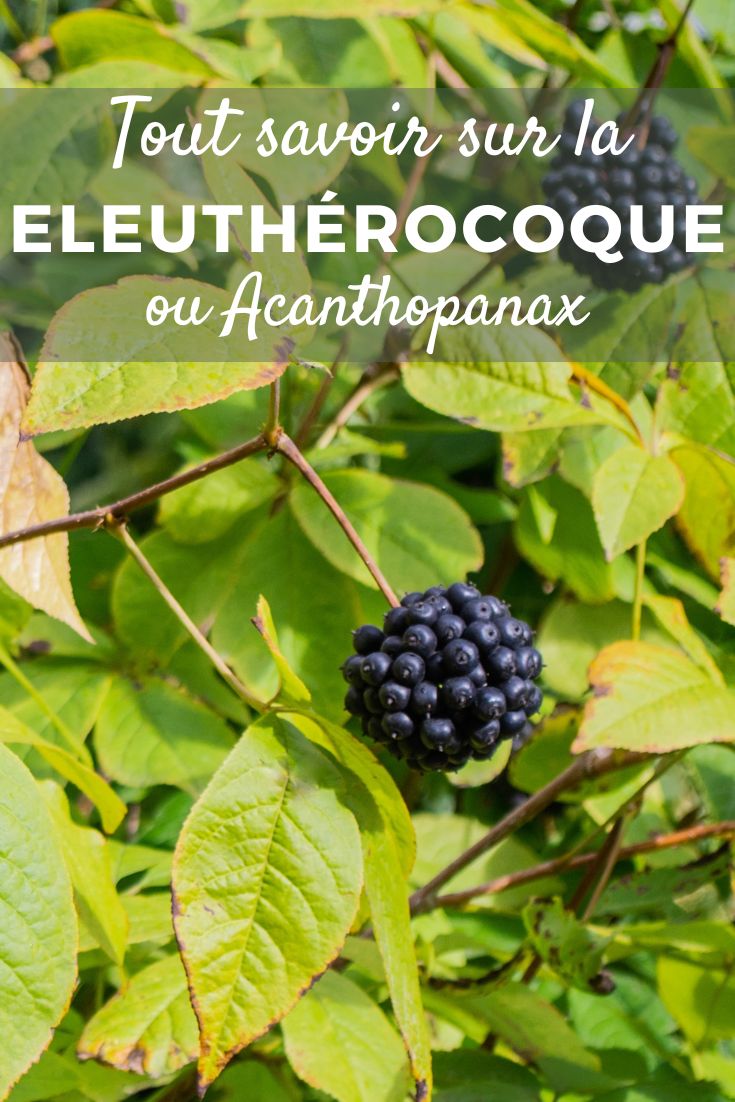































Comments